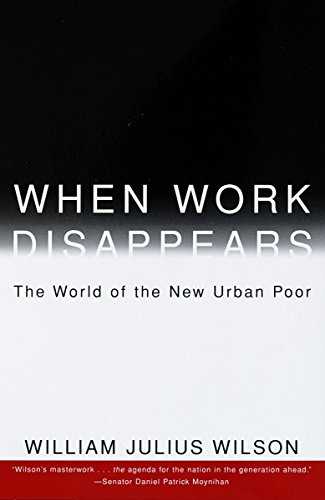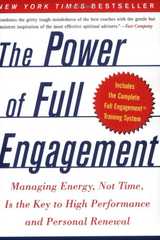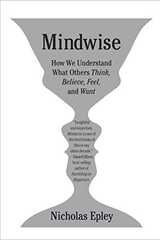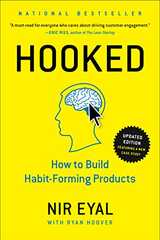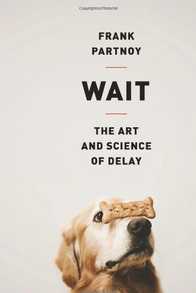
Wait: The Art and Science of Delay
byFrank Partnoy
An important factor to consider in any decision-making process is an estimate of how much time you have to make the decision. Experts, through years of experience and training, can make quick and informed decisions, but novices shouldn't try to replicate the same thing. Partnoy believes that most people can benefit from thinking slower, to take the time to consider those choices and to make the correct decision at the right time. Each chapter focuses on a specific principle of waiting and provides some examples supporting that principle. Partnoy pulls in research and studies from various areas such as sports, the military, biology, neuroscience, and psychology. The books could have used some better organization and much fewer pages.
Motivations to Read
A part of my just wanted to validate some of my decision-making habits as I tend to be very calculated and plan out far in advance while trying to time when is the appropriate moment to act. I would get teased by my mother in my teenage years for delaying my decisions and then she would rush into something without enough information, hah. Gaining a better understanding around the science of decision making and acquiring a mindset for delaying decisions where appropriate will be an important trait to have.
3 Reasons to Read
- Improve your time management skills
- Learn the importance of timing your actions
- You want to improve your patience and become more long-term minded
Notable Quotes
“Psychologists have suggested we have two systems of thinking, one intuitive and one analytical, both of which can lead us to make serious cognitive mistakes.” - Frank Partnoy
“The essence of my case is this: given the fast pace of modern life, most of us tend to react too quickly. We don't, or can't, take enough time to think about the increasingly complex timing challenges we face. Technology surrounds us, speeding us up. We feel its crush every day, both at work and at home. Yet the best time managers are comfortable pausing for as long as necessary before they act, even in the face of the most pressing decisions. Some seem to slow down time. For good decision-makers, time is more flexible than a metronome or atomic clock.” - Frank Partnoy
“During superfast reactions, the best-performing experts instinctively know when to pause, if only for a split-second. The same is true over longer periods: some of us are better at understanding when to take a few extra seconds to deliver the punch line of a joke, or when we should wait a full hour before making a judgment about another person. Part of this skill is gut instinct, and part of it is analytical.” - Frank Partnoy
Wait: The Art and Science of Delay Notes & Summary
High performers instinctively know when to pause.
"The essence of my case is this: given the fast pace of modern life, most of us tend to react too quickly. We don't, or can't, take enough time to think about the increasingly complex timing challenges we face. Technology surrounds us, speeding us up. We feel its crush every day, both at work and at home. The best time managers are comfortable pausing for as long as necessary before they act, even in the face of the most pressing decisions. Some seem to slow down time. For good decision-makers, time is more flexible than a metronome or atomic clock."
Wait tries to answer two important questions:
First, how long should we take to react or decide in a particular situation?
Then, once we have a sense of the correct time, how should we spend our time leading up to the moment of decision?
"As we will see over and over, in most situations we should take more time than we do. The longer we can wait, the better. And once we have a sense of how long a decision should take, we generally should delay the moment of a decision until the last possible instant. If we have an hour, we should wait fifty-nine minutes before responding. If we have a year, we should wait 364 days. Even if we have just half a second, we should wait as long as we possibly can. Even milliseconds matter."
When I first read this, it seemed pretty extreme. Then I realized the goal is to increase the accuracy of your decisions by gathering as much information and other input before the decision needs to be made.
Acting off assumptions has contributed to some mistakes in my life, even when I had enough time to clarify. Take the time to clarify and understand what's needed.
In fast reaction sports like tennis or baseball, the Pros have the ability to gather and process information before they hit.
"Laboratory studies of baseball and cricket confirm that the best professionals are better, not because of what they do during the "see" phase, but because of what they do during the "prepare" phase."
"The superfast athlete's approach of first observing, second processing, and third acting-at the last possible moment-also works well for our personal and business decisions."
When talking about speed and systems, you can't miss out on High-Frequency Trading, which the book talks about.
High-frequency trading (HFT) is a program trading platform that uses powerful computers to transact a large number of orders at very fast speeds. High-frequency trading uses complex algorithms to analyze multiple markets and execute orders based on market conditions. Typically, the traders with the fastest execution speeds will be more profitable than traders with slower execution speeds. As of 2009, it is estimated more than 50% of exchange volume comes from high-frequency trading orders. - Investopedia
High-frequency trading adds liquidity to the market, but it can also add a lot of volatility.
Programmers of these machines, need to build in the logic for them to speed up or slow down their trades.
"The bottom line is that how much latency we want depends on what we are doing. Do we care more about time or cost? If time is the key, we want to move as quickly as we can. We want to minimize latency. But if cost is more important, we can move a bit later, when the time is best. We want to optimize latency. Minimizing delay and optimizing delay are two very different things."
It can be to your benefit to invest time in thinking about the probabilities, playing a poker-like strategy, instead of just moving fast.
"One major advantage experts have over novices is a capacity to make good decisions even when they are loaded with stimulus. Experts can turn off the tap of their conscious minds and still react beautifully based on experience and intuition."
When I read this, I remind myself that Mastery is when your craft becomes intertwined with your being, separate from thought.
"Klein concluded that experts in numerous areas are like grand masters playing blitz chess. They perform well under time pressure, when they shut down their conscious system and trust their gut. And the converse is true: novices perform horrifically under time pressure because they take too long and their gut is wrong. The message is clear: if you only have a few seconds to make a decision, you had better be an expert."
"When we are not experts and we don't have time to compare and choose rationally among options, the best choice is often to do nothing. Because novices are prone to make the wrong move, the right move is often no move at all."
I paused for a bit when I came across this, realizing how much wisdom was in this.
"The best decisions made in time-pressured situations are those we have prepared for in advance."
"Klein suggests that people prepare by doing a "premortem." Whereas a postmortem reviews lessons learned after a decision, a premortem imagines that a future decision has failed and asks why."
The term "thin slicing", people's ability to detect patterns in an event with limited experience to it, was coined in 1992, in the Psychological Bulletin by Nalini Ambaby and Robert Resoenthal.
"If we want to become better thin-slicers, we can prepare in advance and make snap conclusions only when we know they are sufficiently well grounded."
Great communicators naturally understand how long a speech should be: as long as possible, but not a millisecond longer. As Dorothy Sarnoff, the actor, singer, and speech trainer advised, "Make sure you have finished speaking before your audience has finished listening."
Humans / Animals on Time
"The precise timing varies by animal, but two conclusions are apparently based on new experiments: (1) animals can think about the future, and (2) humans can think about the future better, and for longer, than animals."
"Young kids typically don't differentiate the timing of future events until about age five. Even at kindergarten age, they don't think very far ahead."
We get better at thinking about the future as we mature.
Military strategist John Boyd is one of the greatest fighter pilots in American history. He outmaneuvered his opponents not by acting first, but by waiting for them to act and then countering. He believed in precision and speed, in getting to victory.
"Boyd developed a time-based theory of conflict, derived from Sun Tzu, in which the crucial insights for a fighter come in stages: first, observe the rapidly changing environment; second, orient yourself based on these observations, process the disorder, and understand when and how your opponent might become confused; third, decide what to do; and finally, act quickly at just the right moment, when your opponent is most vulnerable."
"This four-step process has become known as OODA (observe-orient-decide-act), or, when repeated in a cycle, the "OODA Loop." The ultimate goal of OODA is to act fast, but not necessarily first."
OODA loop has parallels to "see-prepare-hit" in tennis.
Waiting and Apologies
From On Apology by Aaron Lazare, asking his students on when they should apologize. Most assumed immediately but later saw that waiting could be better.
"Apology timing was positively correlated with outcome satisfaction; when the apology came later in the conflict, participants reported greater satisfaction."
"Saying you are sorry is always better than not apologizing at all. But as with the first study, the students felt better about a delayed apology: "Improvement in the late apology condition was significantly greater than improvement in the early apology condition.""
Reasons To Wait To Give an Apology
"One is that a snap apology can prevent the offended party from expressing how he or she feels, especially after a serious personal transgression. A quick apology might not give the victim enough time to go through the natural emotional response, to understand what the wrongdoer might have been thinking, and to express his or her feelings."
"A second reason to delay an apology is that letting some time pass allows for more information to bubble up around the wrongful act. The victim can learn more about who, what, why, where, and when."
Traits of an Effective Apologies:
- Acknowledge that you did it.
- Explain what happened.
- Express remorse.
- Repair the damage, as much as you can.
"Thaler and the economist George Loewenstein examined how inconsistent humans are about time.[..]
These researchers found that in the short term we are like the impatient four-year-old who cannot wait for a second marshmallow-we have high discount rates. Yet in the longer term, we are better at resisting the pull of temptation-we have lower discount rates."
"The causes of high discount rates are hotly debated, and the environment certainly plays a significant role. For example, evidence suggests that poor people are especially prone to have high short-term discount rates.45 They frame economic decisions in narrow terms, using blinders, which is one reason why so many poor people are trapped by crushing debt loads. Poor people are more likely to get "payday" loans-high-interest-rate advances on their next paycheck."
Procrastination is linked to high discount rates and impatience. Both are linked to humans tendency to over-discount future events.
"As Leonard Bernstein said, "To achieve great things, two things are needed: a plan, and not quite enough time.""
Structured Procrastination
In February 1996, John Perry, a philosophy professor at Stanford University wrote and essay about procrastination for the Chronicle of Higher Education. Here writes:
"All procrastinators put off things they have to do. Structured procrastination is the art of making this bad trait work for you. The key idea is that procrastinating does not mean doing absolutely nothing. Procrastinators seldom do absolutely nothing; they do marginally useful things, such as gardening or sharpening pencils or making a diagram of how they will reorganize their files when they find the time. Why does the procrastinator do these things? Because accomplishing these tasks is a way of not doing something more important. If all the procrastinator had left to do was to sharpen some pencils, no force on earth could get him to do it. However, the procrastinator can be motivated to do difficult, timely, and important tasks, as long as these tasks are a way of not doing something more important."
"Perry's advice is, first, to make a list of the things you have to do. Put a few important tasks at the top-these are the ones you will procrastinate. Then, below them, list some tasks that aren't as important but that you nevertheless need to do. According to Perry, doing these less important tasks "becomes a way of not doing the things higher on the list.""
"The challenge of procrastination is figuring how to weight immediate verse distant consequences."
Make pre-commitments and make it difficult to procrastinate.
Checklists can help us guard against cognitive mistakes. The book The Checklist Manifesto by Atul Gawande talks about how doctors can use checklists to save lives by reducing their mistakes, and lists are helpful in other professions as well.
Steve Kroft Interview
On May 2, 2011, the day Osama bin Laden was shot and killed, Steve Kroft, a journalist for CBS 60 Minutes correspondent and his colleagues used their contacts at the white house to attempt to land an interview with the president. The White House only agreed to 35 minutes, with a program called 60 minutes, this posed a problem on how they would get enough information from the president to fill the program time. Kroft had interviewed Barack Obama many times before and has been a correspondent for 60 minutes since 1989, winning multiple awards using his experience and researching abilities to control the interviews.
Kroft and his team came up with sixty possible questions, yes, six-zero. Some of Kroft's colleagues describe his gift of "timing" if a story is twelve minutes long, he understands exactly how to direct the story and the questions to fit into that time frame.
The day before the interview one of Kroft's producers gave him the final printed list of questions. The day of the interview Kroft, started revising around 5:00 AM, "eliminating questions that would lead to long answers." During the interview, Kroft puts forth closed and very short questions that lead to medium-length answers, which revealed Obama's emotions and short-length answers which revealed new facts.
The interview was a push and pull battle, but a successful one that revealed the thoughtfulness and decisiveness of President Obama in that period around a historical event.
Knowing what's the right question to ask takes asking a lot of questions, a good feel for timing and having an understanding of what you want.
Clock v.s. Event Time
"Much human behavior is based on "clock time," which divides our day into quantifiable units, measured by an objective clock. In clock time, those units dictate when tasks begin and end."
"In event time, we continue doing something until we finish or some event occurs. Then we move on, regardless of whether it has taken ten minutes or a day."
Use a Calendar (event time) when your primary goal is efficiency, getting tasks done as quickly as possible at the optimal times.
Use a to-do list when your primary concern is effectiveness, making sure that the tasks are done, whenever that might be.
"Efficiency goes with clock time; effectiveness goes with event time.
"It is well documented and undeniable that people feel more time pressure today. Yet in fact the median number of hours that people actually work has remained relatively constant during the previous five decades and has declined in recent years."
I found this research interesting. We technically work fewer hours than past generations, but we feel busier and pressured.
The author points to technology being one big culprit. Technology mixes together our personal and professional lives, blurring the boundaries.
Our focus is also under constant assault, and we feel more distracted.
"The word Einstellung means "attitude" in German. The Einstellung effect refers to our tendency to become stuck in our ways, to act or think in the same manner we've always acted or thought, even when we are presented with alternatives that are obviously better."
Two Ways to Defend against the Einstellung effect
- Avoid known, comfortable situations, or at least be acutely aware of their potential drawbacks.
Some companies require employees to move around to different parts or position within the company if they have been in a position for too long.
- Expose work projects to people who are likely to have a different frame of reference.
Diversity in thought and background is important to "cross-fertilize" view points.
Most of life's big questions need to be answered over the long term.
"As Robert J. Sternberg, a Yale psychologist, says, "The essence of intelligence would seem to be in knowing when to think and act quickly, and knowing when to think and act slowly.""
"Our ability to think about delay is a central part of the human condition. It is a gift, a tool we can use to examine our lives. Life might be a race against time, but it is enriched when we rise above our instincts and stop the clock to process and understand what we are doing and why. A wise decision requires reflection, and reflection requires a pause. The converse of Socrates's famous admonition is that the examined life just might be worth living."

